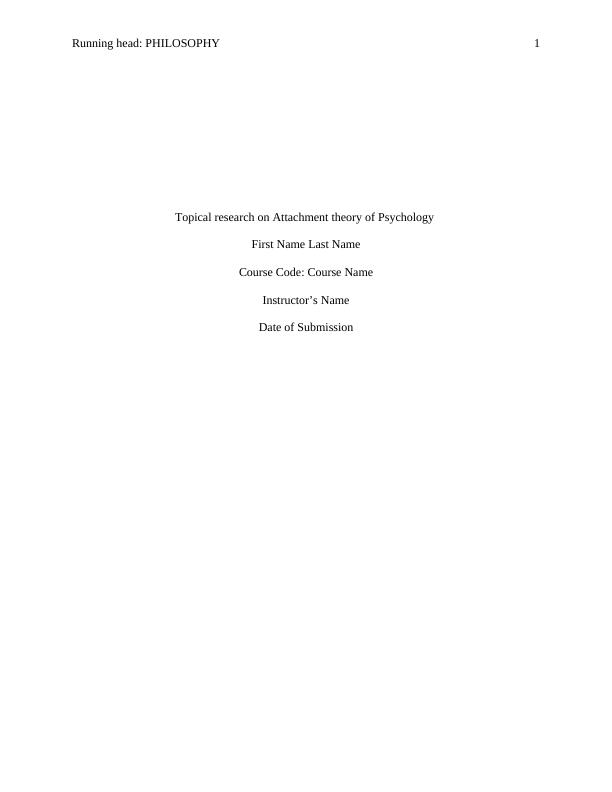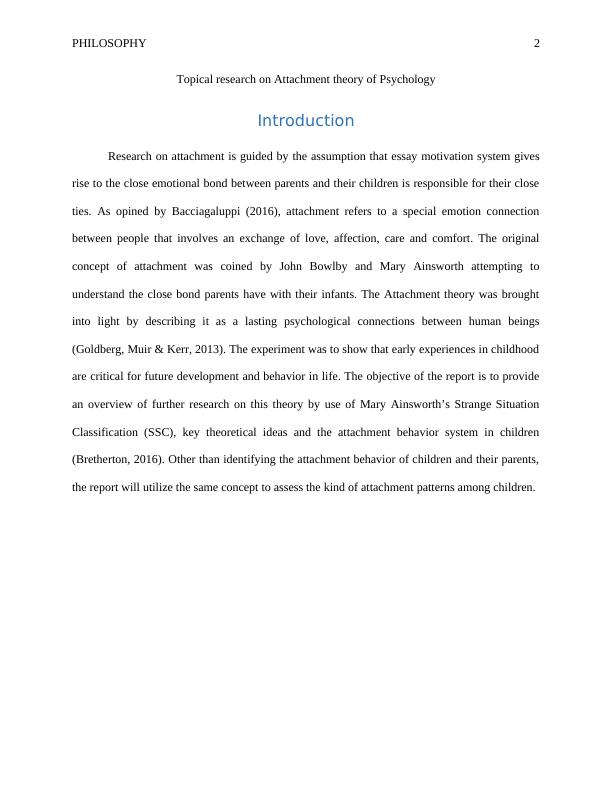Topical research on Attachment theory of Psychology
Added on 2023-04-19
7 Pages1532 Words419 Views
Running head: PHILOSOPHY 1
Topical research on Attachment theory of Psychology
First Name Last Name
Course Code: Course Name
Instructor’s Name
Date of Submission
Topical research on Attachment theory of Psychology
First Name Last Name
Course Code: Course Name
Instructor’s Name
Date of Submission

PHILOSOPHY 2
Topical research on Attachment theory of Psychology
Introduction
Research on attachment is guided by the assumption that essay motivation system gives
rise to the close emotional bond between parents and their children is responsible for their close
ties. As opined by Bacciagaluppi (2016), attachment refers to a special emotion connection
between people that involves an exchange of love, affection, care and comfort. The original
concept of attachment was coined by John Bowlby and Mary Ainsworth attempting to
understand the close bond parents have with their infants. The Attachment theory was brought
into light by describing it as a lasting psychological connections between human beings
(Goldberg, Muir & Kerr, 2013). The experiment was to show that early experiences in childhood
are critical for future development and behavior in life. The objective of the report is to provide
an overview of further research on this theory by use of Mary Ainsworth’s Strange Situation
Classification (SSC), key theoretical ideas and the attachment behavior system in children
(Bretherton, 2016). Other than identifying the attachment behavior of children and their parents,
the report will utilize the same concept to assess the kind of attachment patterns among children.
Topical research on Attachment theory of Psychology
Introduction
Research on attachment is guided by the assumption that essay motivation system gives
rise to the close emotional bond between parents and their children is responsible for their close
ties. As opined by Bacciagaluppi (2016), attachment refers to a special emotion connection
between people that involves an exchange of love, affection, care and comfort. The original
concept of attachment was coined by John Bowlby and Mary Ainsworth attempting to
understand the close bond parents have with their infants. The Attachment theory was brought
into light by describing it as a lasting psychological connections between human beings
(Goldberg, Muir & Kerr, 2013). The experiment was to show that early experiences in childhood
are critical for future development and behavior in life. The objective of the report is to provide
an overview of further research on this theory by use of Mary Ainsworth’s Strange Situation
Classification (SSC), key theoretical ideas and the attachment behavior system in children
(Bretherton, 2016). Other than identifying the attachment behavior of children and their parents,
the report will utilize the same concept to assess the kind of attachment patterns among children.

PHILOSOPHY 3
Describe and Explain
In the opinion of Fonagy (2018), the original concept of attachment theory was John
Bowlby in the year 1969 along with Mary Ainsworth in an attempt to understand the intense
distress experience by infants separated from the parents. Much research in psychology has
focused on the different forms of attachment infants. However, most attachment theories revolve
around infants and young children, so psychologists need to identify subtle ways of researching
attachment styles by use of observational methods. As stated in the report of Bretherton (2016),
the theory of attachment was further explained by Mary Ainsworth famous Strange Situation
Study which involved conducting a test having children between the ages of 12 to 18 months and
recording their responses to a particular situation. In this situation the children where play left
alone and after some point of time reunited with their parents. Based on the observations,
Reijman, Foster & Duschinsky (2018), have mentioned about three major styles of attachment
that were identified namely avoidant insecure attachment, secure attachment and ambivalent
insecure attachment. The results highlighted few important pointers stating that the difference
between sensitive mothers and insensitive mothers and their behavior towards their child. Taking
cues from Bowlby’s attachment theory, it was identified that securely attached children showed
positive behavior about themselves, avoidant children think themselves as unworthy and
unacceptable due to the rejection from primary caregiver, and ambivalent children have a
negative outlook and exaggerate their emotions to seek attention. Along with Ainsworth’s three
majorly identified attachments, researchers Main and Solomon identified a fourth attachment
style known as the disorganized-insecure attachment (Fonagy, 2018). There have several studies
supporting the relevance of Ainsworth’s findings in predicting behaviors in children later in life.
Describe and Explain
In the opinion of Fonagy (2018), the original concept of attachment theory was John
Bowlby in the year 1969 along with Mary Ainsworth in an attempt to understand the intense
distress experience by infants separated from the parents. Much research in psychology has
focused on the different forms of attachment infants. However, most attachment theories revolve
around infants and young children, so psychologists need to identify subtle ways of researching
attachment styles by use of observational methods. As stated in the report of Bretherton (2016),
the theory of attachment was further explained by Mary Ainsworth famous Strange Situation
Study which involved conducting a test having children between the ages of 12 to 18 months and
recording their responses to a particular situation. In this situation the children where play left
alone and after some point of time reunited with their parents. Based on the observations,
Reijman, Foster & Duschinsky (2018), have mentioned about three major styles of attachment
that were identified namely avoidant insecure attachment, secure attachment and ambivalent
insecure attachment. The results highlighted few important pointers stating that the difference
between sensitive mothers and insensitive mothers and their behavior towards their child. Taking
cues from Bowlby’s attachment theory, it was identified that securely attached children showed
positive behavior about themselves, avoidant children think themselves as unworthy and
unacceptable due to the rejection from primary caregiver, and ambivalent children have a
negative outlook and exaggerate their emotions to seek attention. Along with Ainsworth’s three
majorly identified attachments, researchers Main and Solomon identified a fourth attachment
style known as the disorganized-insecure attachment (Fonagy, 2018). There have several studies
supporting the relevance of Ainsworth’s findings in predicting behaviors in children later in life.

End of preview
Want to access all the pages? Upload your documents or become a member.
Related Documents
Secure Attachment Assignment 2022lg...
|8
|2297
|6
Attachment in Children: Understanding the Importance of Secure Bondinglg...
|6
|1517
|87
Attachment Theory and Gender Differences in Secure Attachment Stylelg...
|20
|3103
|189
Q&A on Early Childood Developmentlg...
|6
|1385
|13
Attachment Theory and Parenting Styles: A Case Study Analysislg...
|8
|2085
|296
Attachment Theory: History, Concepts, and Evaluationlg...
|8
|1641
|475
